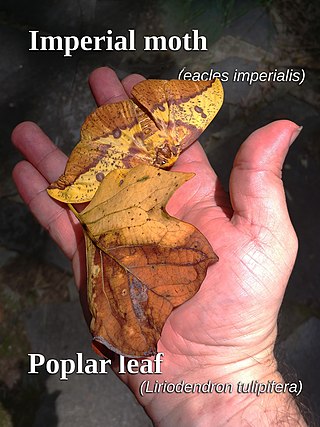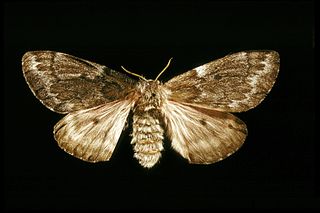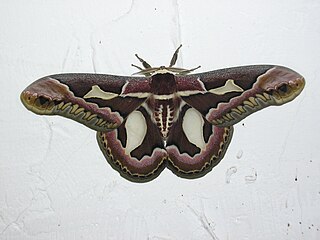
Eacles is a genus of moths in the family Saturniidae. They are native to the Americas. The genus was erected by Jacob Hübner in 1819.

Saturnia is a genus of large silkmoths in the family Saturniidae, which the German biologist Franz von Paula Schrank first described in 1802. Its members are commonly named emperor moths, though this is also used for various close relatives in subfamily Saturniinae. Most species are Palearctic, but three, commonly called "saturnia moths", inhabit the chaparral of California: S. mendocino, S. walterorum, and S. albofasciata.

The Pandora moth or Pandora pinemoth is an insect belonging to the moth genus Coloradia. The species was first described by C. A. Blake in 1863. It is native to the western United States. The larvae of the Pandora moth feed on the foliage of several species of pine trees, including the lodgepole, Jeffrey, and ponderosa pines. The larvae populations sometimes reach high enough levels to cause severe defoliation; such outbreaks have occurred in northern Arizona, central Oregon, and southern California. The Paiute people in California's Owens Valley and Mono Lake areas harvest, prepare, and store the larvae as a preferred food. This has brought the natives into conflict with the United States Forest Service, which has sought to control moth populations through the use of insecticides.

Arsenura is a genus of moths in the family Saturniidae. The genus was erected by James Duncan and John O. Westwood in 1841.

Rothschildia is a genus of moths in the family Saturniidae first described by Augustus Radcliffe Grote in 1896.

Ptiloscola is a genus of moths in the family Saturniidae erected by Charles Duncan Michener in 1949.
Rachesa is a genus of moths in the family Saturniidae first described by Charles Duncan Michener in 1949.
Automerina is a genus of moths in the family Saturniidae first described by Charles Duncan Michener in 1949.
Gamelioides is a genus of moths in the family Saturniidae first described by Claude Lemaire in 1988.
Kentroleuca is a genus of moths in the family Saturniidae first described by Max Wilhelm Karl Draudt in 1930.

Leucanella is a genus of moths in the family Saturniidae first described by Claude Lemaire in 1969.
Meroleuca is a genus of moths in the family Saturniidae first described by Packard in 1904.

Molippa is a genus of moths in the family Saturniidae first described by Francis Walker in 1855.

Ormiscodes is a genus of moths in the family Saturniidae first described by Blanchard in 1852.

Paradirphia is a genus of moths in the family Saturniidae first described by Charles Duncan Michener in 1949.

Periphoba is a genus of moths in the family Saturniidae first described by Jacob Hübner in 1820.

Pseudautomeris is a genus of moths in the family Saturniidae first described by Claude Lemaire in 1967.

Pseudodirphia is a genus of moths in the family Saturniidae first described by Eugène Louis Bouvier in 1928.

Copaxa is a genus of moths in the family Saturniidae first described by Francis Walker in 1855.

Eacles ormondei is a moth of the family Saturniidae. It is found in tropical America.














